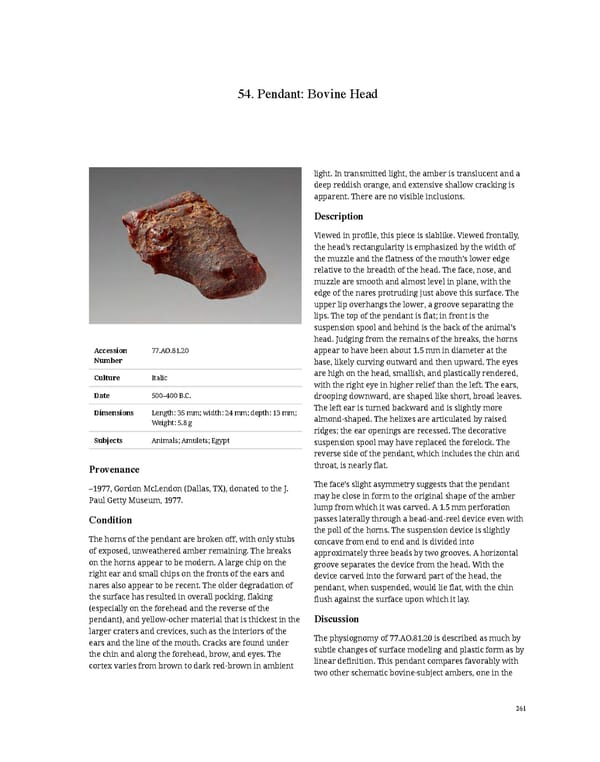54. Pendant: Bovine Head light. In transmitted light, the amber is translucent and a deep reddish orange, and extensive shallow cracking is apparent. There are no visible inclusions. Description Viewed in profile, this piece is slablike. Viewed frontally, the head’s rectangularity is emphasized by the width of the muzzle and the flatness of the mouth’s lower edge relative to the breadth of the head. The face, nose, and muzzle are smooth and almost level in plane, with the edge of the nares protruding just above this surface. The upper lip overhangs the lower, a groove separating the lips. The top of the pendant is flat; in front is the suspension spool and behind is the back of the animal’s head. Judging from the remains of the breaks, the horns Accession 77.AO.81.20 appear to have been about 1.5 mm in diameter at the Number base, likely curving outward and then upward. The eyes Culture Italic are high on the head, smallish, and plastically rendered, with the right eye in higher relief than the left. The ears, Date 500–400 B.C. drooping downward, are shaped like short, broad leaves. Dimensions Length: 35 mm; width: 24 mm; depth: 13 mm; The left ear is turned backward and is slightly more Weight: 5.8 g almond-shaped. The helixes are articulated by raised ridges; the ear openings are recessed. The decorative Subjects Animals; Amulets; Egypt suspension spool may have replaced the forelock. The reverse side of the pendant, which includes the chin and Provenance throat, is nearly flat. –1977, Gordon McLendon (Dallas, TX), donated to the J. The face’s slight asymmetry suggests that the pendant Paul Getty Museum, 1977. may be close in form to the original shape of the amber lump from which it was carved. A 1.5 mm perforation Condition passes laterally through a bead-and-reel device even with the poll of the horns. The suspension device is slightly The horns of the pendant are broken off, with only stubs concave from end to end and is divided into of exposed, unweathered amber remaining. The breaks approximately three beads by two grooves. A horizontal on the horns appear to be modern. A large chip on the groove separates the device from the head. With the right ear and small chips on the fronts of the ears and device carved into the forward part of the head, the nares also appear to be recent. The older degradation of pendant, when suspended, would lie flat, with the chin the surface has resulted in overall pocking, flaking flush against the surface upon which it lay. (especially on the forehead and the reverse of the Discussion pendant), and yellow-ocher material that is thickest in the larger craters and crevices, such as the interiors of the The physiognomy of 77.AO.81.20 is described as much by ears and the line of the mouth. Cracks are found under subtle changes of surface modeling and plastic form as by the chin and along the forehead, brow, and eyes. The linear definition. This pendant compares favorably with cortex varies from brown to dark red-brown in ambient two other schematic bovine-subject ambers, one in the 261
 Ancient Carved Ambers in the J. Paul Getty Museum Page 270 Page 272
Ancient Carved Ambers in the J. Paul Getty Museum Page 270 Page 272